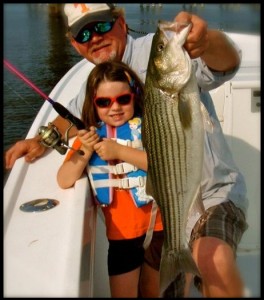 I recently found some old pictures of myself in diapers, standing beside a small wooden boat parked in front of a Tennessee farmhouse. Towering above me was my father, and at my bare feet was a nice stringer of fat largemouth bass. Did I catch them? Probably not, but like any good fisherman, I’ll happily take the credit. I might even tell you a tall tale about how – at the ripe old age of two – I tricked them into biting a lure that I hand carved from a boar’s tusk with a Bowie knife, and how they pulled harder than a Smoky Mountain mule.
I recently found some old pictures of myself in diapers, standing beside a small wooden boat parked in front of a Tennessee farmhouse. Towering above me was my father, and at my bare feet was a nice stringer of fat largemouth bass. Did I catch them? Probably not, but like any good fisherman, I’ll happily take the credit. I might even tell you a tall tale about how – at the ripe old age of two – I tricked them into biting a lure that I hand carved from a boar’s tusk with a Bowie knife, and how they pulled harder than a Smoky Mountain mule.
There’s no doubt that I owe much of what I know about fishing to my father. There’s nothing better than fishing with family. All three of my sons have become first-class fishermen. This week I’ve been fishing with my family’s next generation of anglers. I’ve had a great time on the water with my son Daniel and my granddaughter Ella. I’m happy to report that Chesapeake Bay salinity levels are finally climbing back toward normal levels (see chart below), although they’re still low. Since conditions are stablizing, striped bass fishing is getting a little more reliable. That isn’t to say some days aren’t better than others, but we’re at the point where I at least think we can count on a few fish on any given outing.
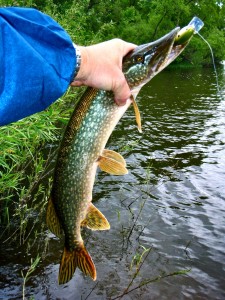 I’ve been off the Bay for well over a week due to some work commitments that took me north to Minneapolis, Minnesota. When this destination was first announced, some of my colleagues were disappointed because of the location. Not me. There aren’t many places I’d rather be because I know how much fun June fishing can be in that part of the country. My first stop was the Minnesota Fishing Museum. It’s located north of St. Cloud in the small town of Little Falls on the Mississippi River. That’s about a hundred miles north of Minneapolis. I’m a big fan of vintage fishing equipment so I had high hopes for the museum. I wasn’t dissapointed. You name it, they had it – everything from antique minnow buckets to classic lures to vintage outboards with even a few old fishing-themed whiskey bottles in the mix. Before we left I asked some ladies at the front desk if there was anyplace close where I could fish the Mississippi River. They told me that most people fished the lakes, but there was a place I could try not too far away.
I’ve been off the Bay for well over a week due to some work commitments that took me north to Minneapolis, Minnesota. When this destination was first announced, some of my colleagues were disappointed because of the location. Not me. There aren’t many places I’d rather be because I know how much fun June fishing can be in that part of the country. My first stop was the Minnesota Fishing Museum. It’s located north of St. Cloud in the small town of Little Falls on the Mississippi River. That’s about a hundred miles north of Minneapolis. I’m a big fan of vintage fishing equipment so I had high hopes for the museum. I wasn’t dissapointed. You name it, they had it – everything from antique minnow buckets to classic lures to vintage outboards with even a few old fishing-themed whiskey bottles in the mix. Before we left I asked some ladies at the front desk if there was anyplace close where I could fish the Mississippi River. They told me that most people fished the lakes, but there was a place I could try not too far away.
I’ll let the video tell the story, but suffice it to say the fishing was good at Blanchard Dam. I’ve heard a lot of good stories about the Mississippi this far north, but never tried fishing here. Every strike brought a different species and I even managed to make some new friends. I even got in some rock hunting, another favorite pastime. “Cross rocks,” they call them. Staurolites that look like Maltese crosses, there are only two other places in the world where they can be found. I never would’ve known except for a fellow I met named Ringwelski. I hit it off with him right away. While it took me ten or fifteen minutes to find a single stone, he could pick them up in a matter of seconds. We fished together two evenings. He told me he owned a farm a few miles up river. Besides being a good rock hunter, he was an excellent fisherman. Read More!
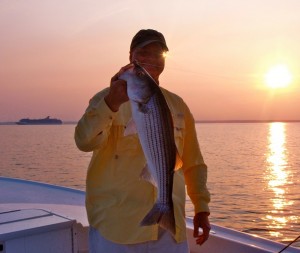 Channel catfish at Hackett’s Bar, carp at the Bay Bridge, snakeheads in St. Jerome’s Creek, and very few stripers in their usual haunts around Kent Island – what’s up with all this late-spring craziness in the Chesapeake Bay? Most fishermen are blaming salt, or more specifically, a lack thereof. Very wet weather in the Susquehanna River watershed has meant lots of fresh water entering the Bay. It’s highly unusual for the Bay to be this fresh in June. Some stations are reporting the lowest readings in recorded history. Salinity is expressed in parts per thousand (ppt), in other words, the number of grams of dissolved salts present in 1,000 grams of water. The water in the Atlantic Ocean is about 35 ppt. Surface salinity today at the Gooses Reef Buoy in the Mid-Chesapeake Bay is 2.0 ppt. That’s low! For better striped bass fishing, we need more salt.
Channel catfish at Hackett’s Bar, carp at the Bay Bridge, snakeheads in St. Jerome’s Creek, and very few stripers in their usual haunts around Kent Island – what’s up with all this late-spring craziness in the Chesapeake Bay? Most fishermen are blaming salt, or more specifically, a lack thereof. Very wet weather in the Susquehanna River watershed has meant lots of fresh water entering the Bay. It’s highly unusual for the Bay to be this fresh in June. Some stations are reporting the lowest readings in recorded history. Salinity is expressed in parts per thousand (ppt), in other words, the number of grams of dissolved salts present in 1,000 grams of water. The water in the Atlantic Ocean is about 35 ppt. Surface salinity today at the Gooses Reef Buoy in the Mid-Chesapeake Bay is 2.0 ppt. That’s low! For better striped bass fishing, we need more salt.
Fishermen have long recognized the importance of locating comfort zones where fish prefer to stay, but sometimes that isn’t so easy. Fishing in late May and early June is usually a challenge, but low salinity levels have made it especially difficult this year. Complicating the matter is that he water can be a lot saltier on the bottom of the Bay than it is on top this time of year. Since, in addition to surface observations, The Gooses Reef Buoy also provides salinity readings from the bottom of the Bay, we can see that it’s currently 7.1 ppt. That’s over three times saltier than it is on the surface. Read More!
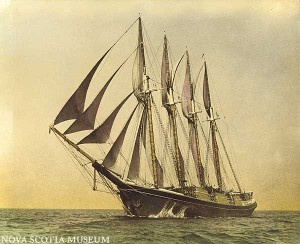 At 7:00 PM on the evening of March 15th, 1912, the four-masted schooner Herbert D. Maxwell left her anchorage near the mouth of the Magothy River and sailed southeast across the Chesapeake Bay toward Kent Island. Built in Maine and designed to haul lumber, the 186 foot cargo ship carried 1150 tons of fertilizer from Baltimore bound for Wilmington, North Carolina. At her helm was her captain and master, William Quillan accompanied by his brother Elay and first mate J.C. Scott. She carried an additional crew of six deck hands. Since winds were mostly calm, it had been slow going down the Chesapeake. After a drowsy sail to just south of Sandy Point, the wind completely died causing Captain Quillan to drop anchor once again. The crew slept until roused by a building northeast breeze at 3:00 AM. Quillan gave the order to the mate to get underway. After pulling anchor and setting sail, The Maxwell ran under clear skies before a 15-knot wind for about 40 minutes when her lookout made an ominous call, “Lights of a steamer, dead-on ahead!” Three minutes later, at 4:44 AM on March 16th, the wooden schooner was ripped apart by the 3200-ton northbound steamship S.S. Gloucester. She sank quickly carrying the first mate and three other crew members to their deaths. Read More!
At 7:00 PM on the evening of March 15th, 1912, the four-masted schooner Herbert D. Maxwell left her anchorage near the mouth of the Magothy River and sailed southeast across the Chesapeake Bay toward Kent Island. Built in Maine and designed to haul lumber, the 186 foot cargo ship carried 1150 tons of fertilizer from Baltimore bound for Wilmington, North Carolina. At her helm was her captain and master, William Quillan accompanied by his brother Elay and first mate J.C. Scott. She carried an additional crew of six deck hands. Since winds were mostly calm, it had been slow going down the Chesapeake. After a drowsy sail to just south of Sandy Point, the wind completely died causing Captain Quillan to drop anchor once again. The crew slept until roused by a building northeast breeze at 3:00 AM. Quillan gave the order to the mate to get underway. After pulling anchor and setting sail, The Maxwell ran under clear skies before a 15-knot wind for about 40 minutes when her lookout made an ominous call, “Lights of a steamer, dead-on ahead!” Three minutes later, at 4:44 AM on March 16th, the wooden schooner was ripped apart by the 3200-ton northbound steamship S.S. Gloucester. She sank quickly carrying the first mate and three other crew members to their deaths. Read More!
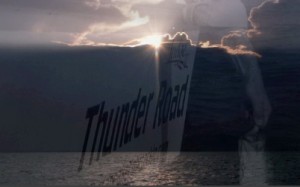 At any given moment there are over 2000 thunderstorms going on around the world. Lately, it seems like most of those are rolling across the Chesapeake. I’ve had several opportunities to fish through the weekend and most of my short trips involved storm dodging. The fishing has been about as unstable as the weather. I’ve taken a couple of complete skunks, had some so-so trips, and finished the weekend with a very successful but somewhat precarious Sunday-evening excursion with Rich and Jamie. We haven’t found a bite in the Upper Bay yet, but the fishing is trying to turn on to the south and east of Kent Island. Most fish are feeding over humps and ledges in the 16-25 foot range, especially over hard oyster bottoms. There is also a decent top-water bite in the shallows at places where the current is visibly moving and fish can find quick access to deeper water. Perch and hard-heads are also lighting up the hard bottoms and can be caught with small metal jigs or scented soft plastic grubs. The water remains very stained. Skies are supposed to be unstable throughout this week. Full-moon currents are ripping so light tackle casting should be pretty good if we can dodge the lightning. Here’s a 2-minute photo montage of our thunder-laced trip Sunday evening trip.
At any given moment there are over 2000 thunderstorms going on around the world. Lately, it seems like most of those are rolling across the Chesapeake. I’ve had several opportunities to fish through the weekend and most of my short trips involved storm dodging. The fishing has been about as unstable as the weather. I’ve taken a couple of complete skunks, had some so-so trips, and finished the weekend with a very successful but somewhat precarious Sunday-evening excursion with Rich and Jamie. We haven’t found a bite in the Upper Bay yet, but the fishing is trying to turn on to the south and east of Kent Island. Most fish are feeding over humps and ledges in the 16-25 foot range, especially over hard oyster bottoms. There is also a decent top-water bite in the shallows at places where the current is visibly moving and fish can find quick access to deeper water. Perch and hard-heads are also lighting up the hard bottoms and can be caught with small metal jigs or scented soft plastic grubs. The water remains very stained. Skies are supposed to be unstable throughout this week. Full-moon currents are ripping so light tackle casting should be pretty good if we can dodge the lightning. Here’s a 2-minute photo montage of our thunder-laced trip Sunday evening trip.
Read More!
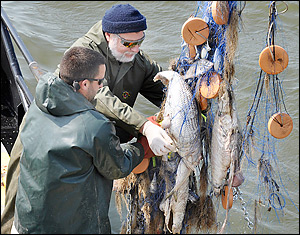 I’ve had my share of embarrassments in recent years. There was the time at a bluegrass show when, immediately after performing “How Many Biscuits Can You Eat,” I choked on a country ham sandwich. I’m the guy who tripped over the curb a while back as I stepped up to shake hands with the Vice President of the United States. I’ve fallen out of boats, pitched backward off barstools, stumbled up escalators, tumbled down stairs, and spilled enough drinks at public dinners to float the Oxford-Bellevue Ferry. Some of my hall-of-shame moments have been painful, and others downright funny, but there’s nothing remotely entertaining about my most recent embarrassment. In fact, everyone in Maryland shares my latest shame. Last week, Chesapeake Bay anglers found and reported another fourteen hundred yards of illegal gill net containing more than three tons of dead and rotting fish. Add another nickname to the list that includes The Free State and The Old Line State: Maryland – The Poaching State. Read More!
I’ve had my share of embarrassments in recent years. There was the time at a bluegrass show when, immediately after performing “How Many Biscuits Can You Eat,” I choked on a country ham sandwich. I’m the guy who tripped over the curb a while back as I stepped up to shake hands with the Vice President of the United States. I’ve fallen out of boats, pitched backward off barstools, stumbled up escalators, tumbled down stairs, and spilled enough drinks at public dinners to float the Oxford-Bellevue Ferry. Some of my hall-of-shame moments have been painful, and others downright funny, but there’s nothing remotely entertaining about my most recent embarrassment. In fact, everyone in Maryland shares my latest shame. Last week, Chesapeake Bay anglers found and reported another fourteen hundred yards of illegal gill net containing more than three tons of dead and rotting fish. Add another nickname to the list that includes The Free State and The Old Line State: Maryland – The Poaching State. Read More!


